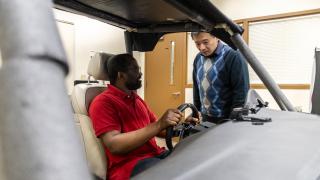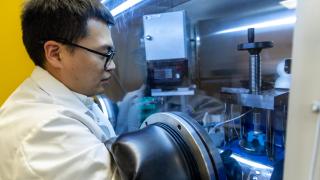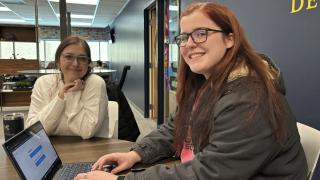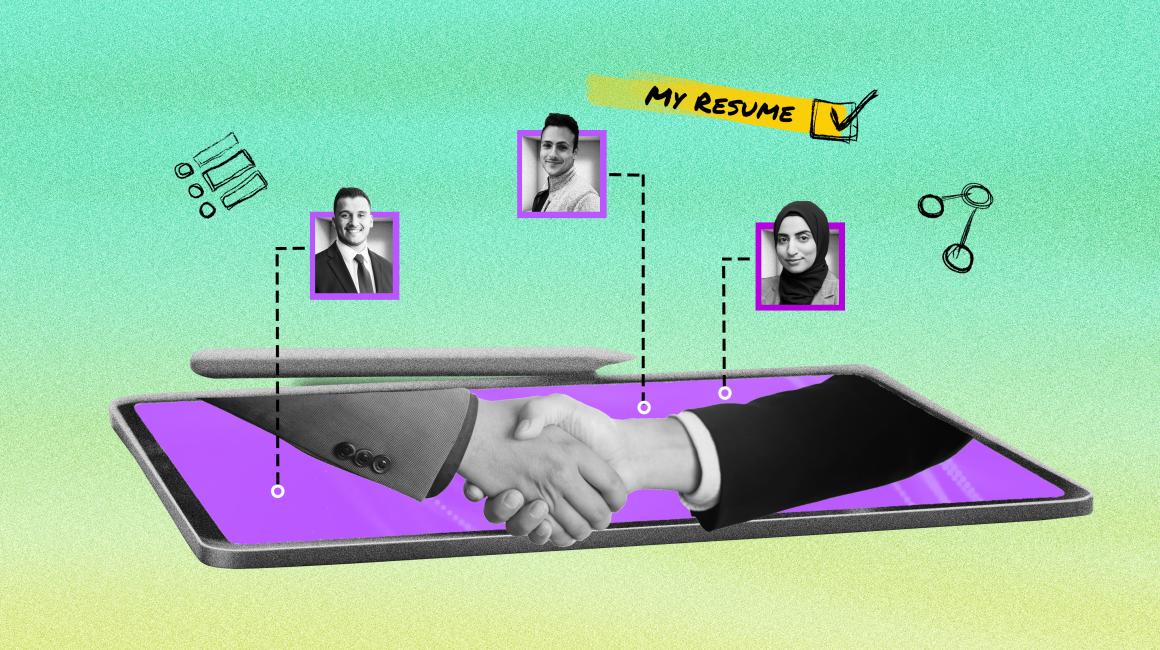
This article was originally published on August 31, 2020.
Finance senior Faris Ajluni planned to move to New York City for the summer to work on Wall Street. Seniors Douaa Al-Jebori and Jacob Agemy, who both recently applied to medical school, thought they would be doing clinical research in a large hospital’s 24-hour Emergency Room.
With safety restrictions and stay-at-home orders in place, things didn’t unfold as expected. But each student said they saw a silver lining — learning how to navigate the newly expanded home-based work world.
Here are experiences and advice from three UM-Dearborn students on how to make the most of any opportunity — including virtual ones.
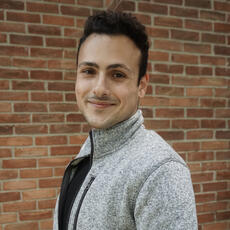
Faris Ajluni
Senior in finance
Experience: Standard & Poor’s internship, New York City
The resume was ready. The suit was on. And Faris Ajluni stood in front of a 22-story office building in New York City’s Financial District. Along with members of the College of Business’ Financial Management Association (FMA), Ajluni traveled to NYC in early March to meet banking industry powerhouses for professional advice and job leads.
After visiting the S&P office, Ajluni’s phone rang while on the subway.
“They wanted to talk with me about my resume,” Ajluni said. “I’ve wanted to work for a company like S&P since I found drawing graphs for stock market option trading in my grandpa’s garage when I was 13. I was ready.”
Ajluni landed an internship with S&P as a Risk Management Summer Analyst. But Ajluni’s dream gig moved from a Manhattan high rise to a bedroom workstation.
Here’s what he had to say about it.
Instead of moving to New York and the mental preparation that comes with that, your first day at S&P began by turning on your computer. How did you prepare yourself?
We all know it’s easy to be lazy, especially when hanging out in your pjs, having a laptop in bed and whatnot. So I didn’t let myself go there. I set up a home office with a monitor. I also upgraded my Internet connection. I know that it can be an expensive thing to do, but I saw it as an investment — I wanted to come across as confident and organized during presentations; I didn’t want to be remembered as the guy who kept cutting out and was blurry. I decided that I’d get ready every morning, even if I didn’t have a meeting. And since I’m more focused in the morning, I planned to schedule my more difficult tasks from 8 a.m. to noon. When you are in charge of your schedule and you have goals you want to reach, it’s all about being honest with yourself about your strengths and weaknesses and then doing things to accentuate your pros and minimize the cons.
How were you able to build your network and what advice would you give others?
This was my first virtual internship, but I’ve done internships before this one. The surprising thing I learned about virtual networking is that it’s easier to get a Zoom meeting than it is to get a meeting in someone’s office. All you have to do is ask and let them know what it’s about. It was that simple. Maybe it’s because the commute time is no longer an issue or that people can better balance their work and home life, which gives more flexibility. I got to meet CEOs and CFOs of major companies. Since people are more willing to give their time, it gives you the opportunity to build strong networks. So be professional and prepared to ask and answer questions so you don’t waste your time or theirs.
What did your internship teach you?
Many things might not be in person, but the world hasn’t stopped. Everyone is still moving forward; it’s just done differently.
S&P was interested in me because I had previous internships; leadership roles in campus organizations like the FMA, and worked with a tech startup. So build your resume. Don’t sit and wait for things to go back to in-person. Opportunities are still out there — they are just done virtually. What you will gain from putting yourself out there now will help you no matter what the world looks like in the future.
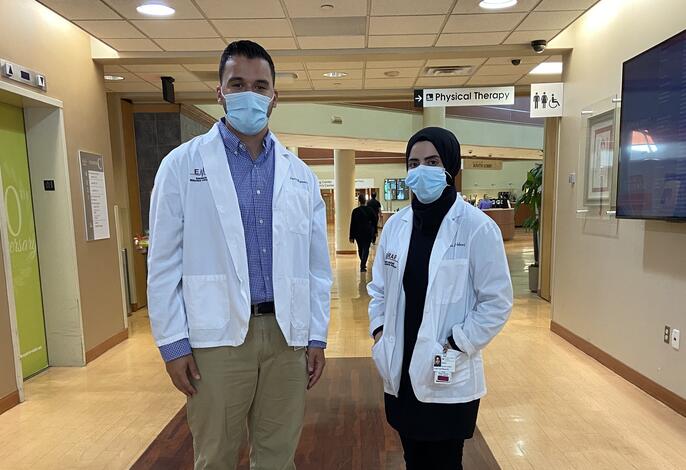
Jacob Agemy
Senior in Biological Sciences
Douaa Al-Jebori
Senior in Health Policy Studies
Experience: Emergency Medical Research Associate Program (EMRAP), St. Mary Mercy Hospital, Livonia
Jacob Agemy and Douaa Al-Jebori’s workstation sat in the middle of the St. Mary Mercy Hospital Emergency Room.
Through the UM-Dearborn-St. Mary’s Emergency Medical Research Associate Program (EMRAP) partnership, the undergraduate students shadowed doctors, designed clinical research studies, and gathered research data by reviewing patient charts and conducting patient interviews.
Both students — who are on the pre-med track and plan to be doctors — began the experience in 2019 to gain research experience and see what it’s like to work in a busy hospital setting.
But in March, things began to change. “One day it was business as usual, and the next it was wild. Phones were constantly ringing to see if we had COVID patients there. There was a shortage of PPE. People were coming in with any possible symptom to get tested,” Al-Jebori says. “It happened in front of me while I was in the middle of the ER.”
When their ER location moved to a virtual one for safety reasons, the UM-Dearborn students — who were promoted to EMRAP student supervisor roles this year — were challenged to reimagine the program in a new virtual environment so it could continue in the 2020-2021 academic year.
Here’s what they had to say.

There’s a lot to learn in a hospital setting, but what’s a non-medical takeaway from your experience?
Douaa Al-Jebori: I’ve learned that if you need to adapt to a new environment quickly, it can be done. We moved EMRAP completely online, created a virtual orientation and training program, hired 10 new student research associates — and kept everything on schedule.
Jacob Agemy: I learned you can build a good team too. After hiring our team, we worked on getting to know each other since many of us never met in person before. We did ice breakers like, “Tell me something interesting about you.” People would share and the rest of the group would find similarities. For example, one person said he was a Taekwondo black belt, and another said they were too. Our EMRAP team all got to meet in person for the first time on Friday because we can work at the hospital again. There wasn’t nervous energy. People were sharing stories and laughing. It showed me how well people can connect with each other even when it’s an online-only environment.
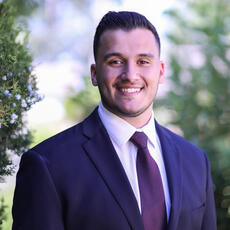
How will this experience help you in the future?
Agemy: During a major medical crisis, I’ve had direct contact with doctors, professors and researchers. A St. Mary’s infectious diseases doctor has spoken with our EMRAP group. Things are constantly evolving, but I am relatively well informed. Then when I get on social media, the COVID information some of my friends and family share is not accurate — but they strongly believe it is. They take unsourced Twitter videos or poorly written articles as medical facts and advice. It’s been eye opening and a little scary to see all the misinformation out there. This experience has taught me how important it is to check the publication source or search a reliable database — for medical research, PubMedis where to go — before I repeat something as a fact. Obviously that’s important with going into the medical field, but it’s an important thing to do on a personal level too.
What advice would you give someone who is creating a new virtual experience?
Al-Jebori: You cannot go in underprepared and expect to pull it off. That may work in person because there’s a natural energy in the room and social cues are easier to read. But when you are online, it takes a little more facilitation and organization to get and keep people engaged. We have an agenda, try to give breaks — hours of Zoom meetings can be exhausting — and do ice breakers so people get to know each other. And if things don’t go as you expect, just acknowledge it and keep going. Don’t get upset with yourself. People are more empathetic than you’d expect — we are all in this together.

